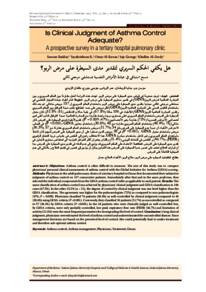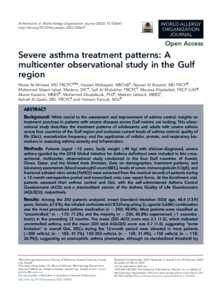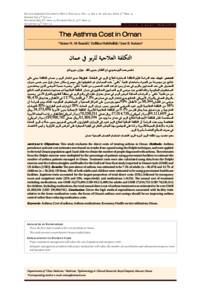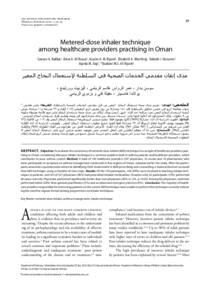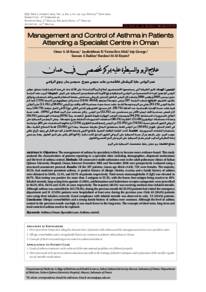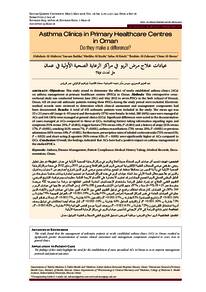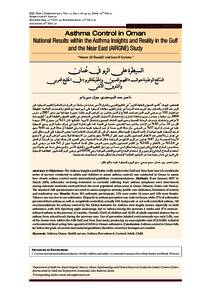Document
Is Clinical judgment of asthma control adequate? : a prospective survey in a tertiary hospital pulmonary clinic.
Contributors
Other titles
هل يكفي الحكم السريري لتقدير مدى السيطرة على مرض الربو؟: مسح استباقي في عيادة الأمراض التنفسية بمستشفى مرجعي ثالثي
Publisher
College of Medicine, Sultan Qaboos University.
Gregorian
2013-02
Language
English
English abstract
Objectives: Asthma control is often difficult to measure. The aim of this study was to compare
physicians' personal clinical assessments of asthma control with the Global Initiative for Asthma (GINA) scoring.
Methods: Physicians in the adult pulmonary clinics of a tertiary hospital in Oman first documented their subjective
judgment of asthma control on 157 consecutive patients. Immediately after that and in the same proforma, they
selected the individual components from the GINA asthma control table as applicable to each patient. Results: The
same classification of asthma control was achieved by physicians' clinical judgment and GINA classification in 106
cases (67.5%). In the other 32.5% (n = 51), the degree of control by clinical judgment was one level higher than the
GINA classification. The agreement was higher for the pulmonologists (72%) as compared to non-pulmonologists
(47%; P = 0.009). Physicians classified 76 patients (48.4%) as well-controlled by clinical judgment compared to 48
(30.6%) using GINA criteria (P <0.001). Conversely, they classified 34 patients (21.7%) as uncontrolled as compared
to 57 (36.3%) by GINA criteria (P <0.001). In the 28 patients who were clinically judged as well-controlled but,
by GINA criteria, were only partially controlled, low peak expiratory flow rate (PEFR) (46.7%) and limitation of
activity (21.4%) were the most frequent parameters for downgrading the level of control. Conclusion: Using clinical
judgment, physicians overestimated the level of asthma control and underestimated the uncontrolled disease. Since
management decisions are based on the perceived level of control, this could potentially lead to under-treatment
and therefore sub-optimal asthma control.
Sponsorship
Sultan Qaboos University
Member of
Resource URL
Citation
Baddar, Sawsan, Jayakrishnan, B., Al-Rawas, Omar, George, Jojy, & Al-Zeedy, Khalfan (2013). Is Clinical Judgment of Asthma Control Adequate?: A prospective survey in a tertiary hospital pulmonary clinic. Sultan Qaboos University Medical Journal, 13 (1), 6
Arabic abstract
الهدف: توجد صعوبة في قياس مدى السيطرة على مرض الربو. تهدف هذه الدراسة لعمل مقارنة بين الحكم السريري وبين المبادرة العالمية لمرض الربو (GINA) في تقدير مستوى السيطرة على مرض الربو. الطريقة: قام أطباء عيادة الجهاز التنفسي في مستشفى مرجعي ثالثي مبدئيا بتقدير مدى السيطرة على مرض الربو باستخدام الحكم السريري ل157 مريض متتالي. ثم بعد ذلك باستخدام التقدير المبني على المبادرة العالمية للربو (GINA) لكل مريض على حدة. النتائج: بلغت نسبة التوافق بين الحكم السريري وتقدير المبادرة العالمية للربو (GINA) للأطباء في 106 حالة (6705%). في بقية حالات التناقض 51 (32.5%) كان معدل السيطرة على المرض باستخدام الحكم السريري أعلى بمستوى درجة واحدة مقارنة مع المبادرة العالمية. نسبة التوافق كانت أعلى لدى أخصائيي أمراض الصدر (72%) مقارنة بغير الأخصائيين (47%) (P = 0.009). تقدير الأطباء لمدى السيطرة على المرض كان مثالي ل76 (48.4%) باستخدام الحكم السريري مقارنة مع 48 (30.6%) باستخدام معايير المبادرة العالمية للربو (P<0.001). في الجانب الآخر قدر الأطباء أن نسبة عدم السيطرة على المرض بلغ 34 (21.7%) مريض باستخدام الحكم السريري مقارنة مع 57 (36.3%) مريض باستخدام معيار المبادرة العالمية. (P<0.001) في 28 مريض الذين صنفوا على أن مدى السيطرة على المرض لديهم كان كاملا باستخدام الحكم السريري وغير كامل باستخدام مبادرة GINA. هذا الاختلاف راجع إلى النقص في مقياس ذروة التدفق الزفيري (PEFR) (47%) والنقص في النشاط اليومي (21.4%) واللذان يعتبران أكثر العوامل المؤدية إلى انخفاض مستوى التباين في تقدير مستوى السيطرة على المرض. الخلاصة: الاعتماد على الحكم السريري قد يؤدي إلى عدم الدقة في تقدير مدى السيطرة على المرض. بما أن قرارات العلاج تعتمد على تصور نسبة السيطرة على المرض، هذا التباين يمكن أن يؤدي إلى قصور في تقديم العلاج وبالتالي إلى عدم السيطرة الكاملة على المرض.
Category
Journal articles

